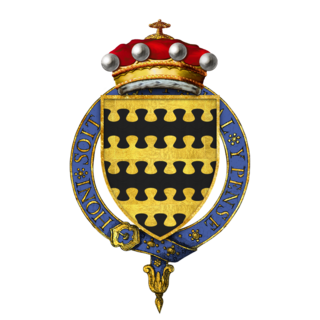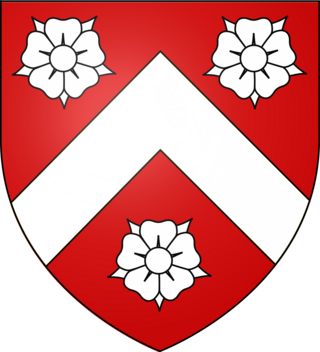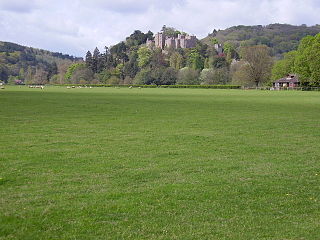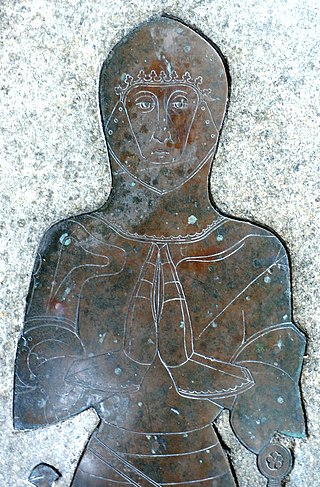
William Stourton, 2nd Baron Stourton (died 1478) was an English nobleman, politician and administrator. [1] [2]

William Stourton, 2nd Baron Stourton (died 1478) was an English nobleman, politician and administrator. [1] [2]
Born before 1426, he was the son and heir of John Stourton, 1st Baron Stourton, [1] and his wife Margaret, daughter of Sir John Wadham of Edge, Branscombe, Devon, Justice of the Common Pleas, and his second wife Joan Wrottesley. [2]
In 1447 he was elected Member of Parliament for Dorset, gaining the seat again in 1460, and by 1450 had been knighted. In that year he was on a commission of oyer and terminer for treasons in Wiltshire, followed in 1451 by appointment to the commission of the peace for Dorset, sitting later for Somerset and for Wiltshire as well. In 1455 he was the commissioner responsible for collecting Dorset's contribution to the defence of Calais and was ordered by the Privy Council to assist the Duke of York in quelling disturbances in Devon. Between 1457 and 1466 he was on the commission of array and on the commission of oyer and terminer for Dorset, Hampshire, Somerset and Wiltshire. [2]
In 1462 he inherited his father's lands and title, being summoned to Parliament as a baron between 1469 and 1472. [2] In 1469 he was one of the commission for treasons which condemned Henry Courtenay, of West Coker, and Sir Thomas Hungerford, of Rowden to execution for treason at Salisbury, [3] and in 1471 acted as arbitrator in a dispute there between the bishop, Richard Beauchamp, and the city authorities. [2]
He died on 18 February 1478 and was buried in the church of St Michael at Mere in Wiltshire. [1] [2]

Before 18 May 1450, he married Margaret, eldest daughter and coheiress of Sir John Chideock, [1] of Chideock, and his wife Catherine, daughter of Ralph Lumley, 1st Baron Lumley. [2] Their children included:
His widow remarried John Cheney, Baron Cheyne, who died on 30 May 1499, and herself died on 12 March 1503. [2]

Henry Stafford, 1st Earl of Wiltshire was an English peer.

William Blount, 4th Baron Mountjoy, KG, of Barton Blount, Derbyshire, was an extremely influential English courtier, a respected humanistic scholar and patron of learning. He was one of the most influential and perhaps the wealthiest English noble courtier of his time. Mountjoy was known internationally as a humanist writer and scholar and patron of the arts.

Sir Thomas Arundell of Wardour Castle in Wiltshire was a Cornish administrator and alleged conspirator.
Margaret Beauchamp was the oldest daughter of Sir John Beauchamp of Bletsoe, and his second wife, Edith Stourton. She was the maternal grandmother of Henry VII.
Sir John Cheyne, Baron Cheyne, was Master of the Horse to King Edward IV of England and personal bodyguard to King Henry VII of England.

John Stourton, 1st Baron Stourton of Stourton, Wiltshire, was an English soldier and politician, elevated to the peerage in 1448.

Sir John Courtenay was the third son of Thomas Courtenay, 13th Earl of Devon, and Margaret Beaufort, and was styled Earl of Devon by Lancastrians in exile, following the execution of his brother the 14th earl in 1461.

Ralph Lumley, 1st Baron Lumley was an English nobleman, soldier and administrator under King Richard II, who was stripped of his lands, goods and title and executed for rebelling against King Henry IV.

Thomas de Courtenay, 5th/13th Earl of Devon was a nobleman from South West England. His seat was at Colcombe Castle near Colyton, and later at the principal historic family seat of Tiverton Castle, after his mother's death. The Courtenay family had historically been an important one in the region, and the dominant force in the counties of Devon and Cornwall. However, the rise in power and influence of several gentry families and other political players, in the years leading up to Thomas' accession to the earldom, threatened the traditional dominance of the earls of Devon in the area. Much of his life was spent in armed territorial struggle against his near-neighbour, Sir William Bonville of Shute, at a time when central control over the provinces was weak. This feud forms part of the breakdown in law and order in England that led to the Wars of the Roses.

Sir Humphrey Stafford, 1st Earl of Devon, 1st Baron Stafford of Southwick was a dominant magnate in South West England in the mid-15th century, and a participant in the Wars of the Roses. A distant relative of the Earls of Stafford, Humphrey Stafford became the greatest landowner in the county of Dorset through fortunes of inheritance. Later, Stafford was one of several men promoted rapidly through the nobility by King Edward IV, to fill the power vacuum left by dead or forfeit Lancastrians. In the West Country it was particularly the forfeitures of the Lancastrian Courtenay family that benefited Stafford. In 1469 he received the Courtenay title of Earl of Devon.

John Seymour of Stapleford in Wilton, Wiltshire, and of Wulfhall in Savernake Forest, Wiltshire was an English landowner and Member of Parliament.

John Seymour of Wulfhall, of Stalbridge, of Stinchcombe and of Huish, all in Wiltshire, England, was warden of Savernake Forest and a prominent member of the landed gentry in the counties of Wiltshire, Somerset and Dorset. He was the grandfather of Jane Seymour, the third wife of King Henry VIII, and was thus great-grandfather of King Edward VI.
Henry Grey, 4th Baron Grey of Codnor was an English nobleman of the fifteenth century. Having initially supported the House of Lancaster during the Wars of the Roses, he later gave his allegiance to the victorious King Edward IV. Despite a record of conflict with other members of the nobility, he enjoyed the confidence of the King, who appointed him Lord Deputy of Ireland, an office in which he was a notable failure. He retained the favour of two later monarchs, Richard III and Henry VII, both of whom made him grants of land.
Katherine Stourton, Baroness Grey of Codnor was an English noblewoman. Her life reflects the turbulence of English political life in the late fifteenth and early sixteenth centuries; her first husband was attainted for treason, and her third husband holds the record for the longest period of imprisonment in the Tower of London.

Sir Nicholas Wadham was an English landowner, courtier, politician, and civil and military administrator from Somerset. His inherited landholdings over three counties included Merryfield in Ilton in Somerset, Catherston Leweston in Dorset, and Edge in Branscombe in Devon.

The feudal barony of Dunster was an English feudal barony with its caput at Dunster Castle in Somerset. During the reign of King Henry I (1100–1135) the barony comprised forty knight's fees and was later enlarged. In about 1150 the manors retained in demesne were Dunster, Minehead, Cutcombe, Kilton and Carhampton in Somerset, and Ham in Dorset.

Sir William Wadham (c.1386–1452) of Merryfield in the parish of Ilton, Somerset and Edge in the parish of Branscombe, Devon came from a West Country gentry family with a leaning towards the law, who originally took their name from the manor of Wadham in the parish of Knowstone, between South Molton and Exmoor, north Devon.

William Stafford of Southwick, Wiltshire, was an English gentleman who was killed in June 1450 during Jack Cade's Rebellion, together with his second cousin Sir Humphrey Stafford of Grafton in the parish of Bromsgrove, Worcestershire. Both appear as characters in Shakespeare's play Henry VI, Part 2, in which they are described as brothers.
Sir John IV Chideock was an English landowner, administrator, soldier, and politician who lived at Chideock in Dorset and sat as Member of Parliament for the county in 1414.